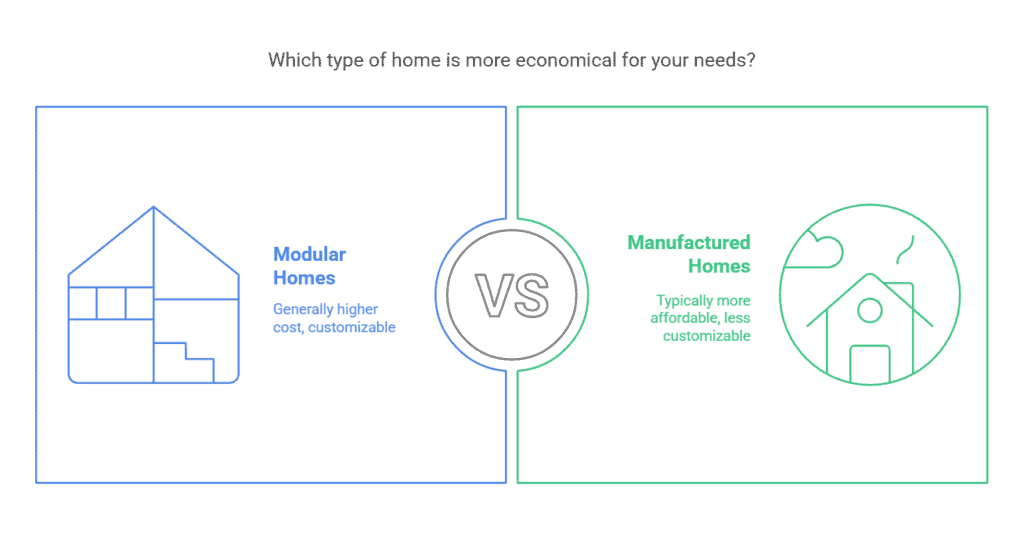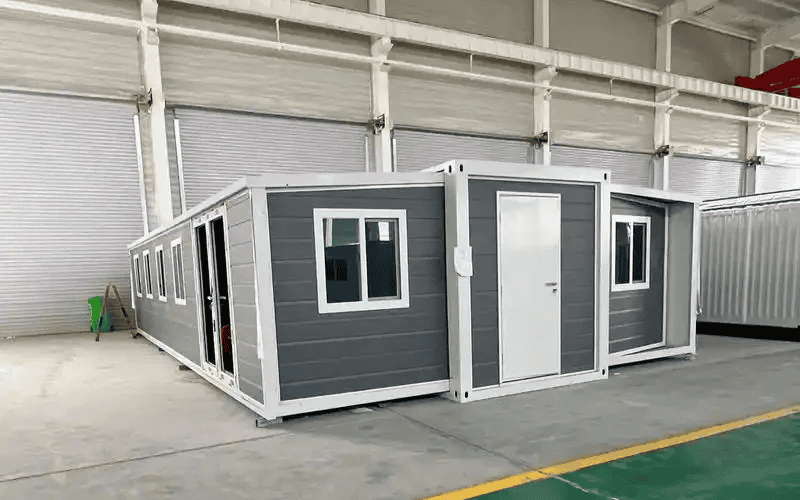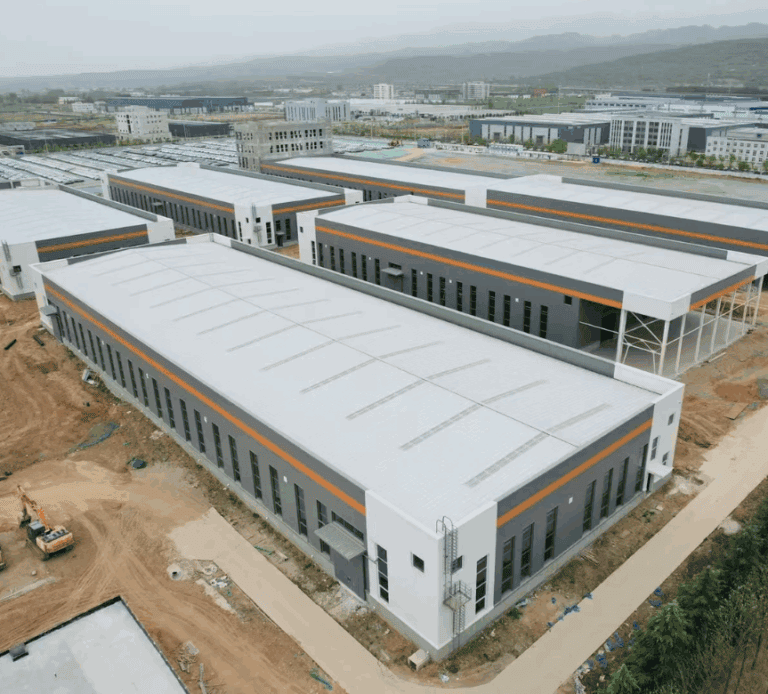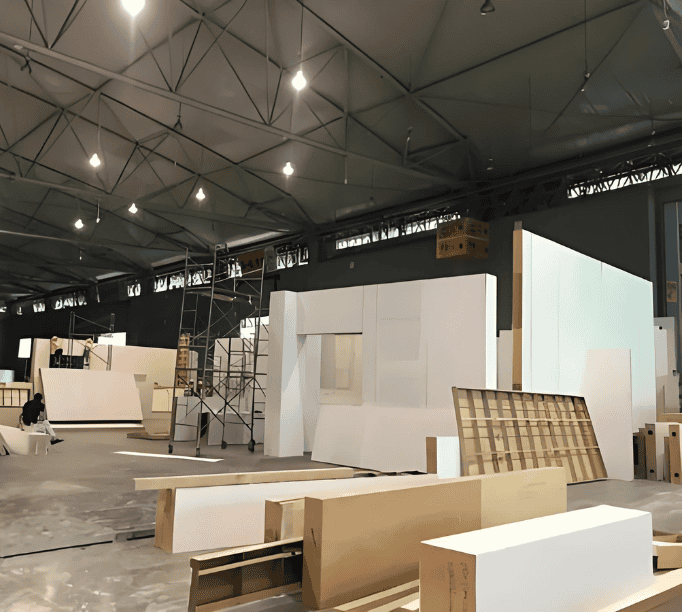Have you ever wondered: Why is there such a big price difference for houses built in the same factory? In today’s tight housing budget, the “twins” of modular homes and manufactured homes are often confused. Some people say that the former is more cost-effective, while others insist that the latter is the king of cost-effectiveness – but what is the truth?
In fact, the “saving logic” of these two types of houses is completely different. One is like a hardcover package, which is cheap in the early stage but may hide hidden bills; the other is like a customized service, which has a high initial investment but can save “steady water for a long time”. We will use real data to dismantle their initial costs, hidden fees and long-term value to help you find the most suitable option for your wallet. After all, every penny saved is the confidence of future life.
1. Modular vs. Manufactured Homes in Upfront Cost: Which one has a lower threshold?
Buying a house built in a factory is like choosing a fast food meal – a manufactured home is a “basic hamburger”, while a modular home is a “customized luxury meal”. The difference in the starting price between the two is enough to make a Tesla, and the key lies in the “underlying logic of cost saving”.
Why are manufactured homes cheap?
Its price is usually $50,000-$150,000 (including transportation and installation), which is equivalent to 1/3 of traditional houses. The secret lies in the “federal unified standard”: manufactured homes across the United States are built according to HUD specifications, and doors, windows, walls, and even circuit systems are mass-produced like factory assembly lines. This “national universal manual” greatly reduces the design and material costs – but it also means that you cannot change the house type at will. After all, “standardization” is the core of low prices.
Why are modular homes expensive?
Its price tag is often $100,000-$250,000+, close to traditional houses. Although it is also assembled in the factory, it must comply with local building codes: such as Florida’s hurricane resistance requirements and Colorado’s snow load standards. This means that the foundation must be reinforced with steel and concrete (not cheap brackets like manufactured houses), the walls must be soundproofed, and the circuits must be wired according to local fire regulations – these “invisible upgrades” push up the cost, but also make it more like a “real house.”
Which one to choose if the budget is tight?
If you only have less than $100,000, manufactured houses are the only choice. But if the budget exceeds $150,000, you might as well compare the long-term benefits of modular houses – after all, the extra money you spend is to buy the “real estate” attributes when you resell it in the future, not just “movable assets.”
2. Modular vs. Manufactured Homes in Hidden Fees: “Additional Bills” for Low-Price Packages
You thought it was over after paying the house price? Wrong!
Foundation: An invisible money-burning black hole
Modular homes must have a permanent foundation like traditional homes – imagine pouring a giant cement slab on the land ($20,000–$50,000). This money is enough to buy a used Corolla, but it can prevent the house from sinking and cracking. manufactured homes only need to use steel frames or concrete piers ($5,000–$15,000) to support the house, just like “laying Lego bricks” under the house.
Real case:
California resident Sarah chose a $120,000 manufactured home, but found that the hillside needed additional foundation reinforcement, which cost an extra $8,000. “The salesman didn’t tell me that the geological report would be charged separately!”
Transportation: Distance is the enemy of money
The “building blocks” of modular homes are large and heavy (often over 15 tons), and transportation requires special permits and escort vehicles, costing up to $10-$15 per mile. 300 miles from the factory to the construction site? The freight cost easily exceeds $15,000. manufactured homes are like “foldable RVs”, and the overall transportation cost is only $3-$8 per mile, which can save $5,000+ for the same distance.
Budgeting Guide
- Modular Homes: Set aside **15%-25%** of the total budget for foundations and transportation
- manufactured Homes: Give priority to plots within 100 miles of the factory, and the freight cost can be reduced to less than $5,000

3. Modular vs. Manufactured Homes in Long-term Costs: Who is the “friend of time”?
If you compare a house to an investment, a modular home is a fixed deposit that increases steadily in value; a manufactured home is like a new mobile phone that depreciates as soon as you get it – the key is whether you can accept the “time tax”.
Appreciation potential: real estate certificate vs. property certificate
Modular homes have the same real estate property rights as traditional houses, and they increase with the appreciation of the land (about 3%-5% per year). The property certificate of a manufactured home is more like a “vehicle registration certificate”. Once installed, the value begins to shrink – after 10 years, it may only be 50%-70% of the original price, just like the depreciation of a used car.
Real case:
A Texas couple spent $80,000 to buy a manufactured home in 2015, and only quoted $45,000 when they sold it in 2023; their neighbor bought a modular home for $180,000 in the same year, but sold it for $220,000.
Bill assassin: Where is the difference in energy efficiency?
Modular homes come standard with double-glazed windows + high-density insulation, and air conditioning costs are 10%-15% lower than traditional homes.
The wall thickness of manufactured homes is usually 2 inches less, and single-glazed windows leak air, so winter heating costs may be $500+/year more.
If you want to upgrade insulation or install solar panels, manufactured homes will cost an additional $8,000–$15,000 (modular homes usually include this).
Budgeting Guide
- Plan to live <10 years: manufactured homes are more cost-effective (depreciation loss < modular premium)
- Plan to live >15 years: modular energy saving + appreciation benefits can cover the initial price difference
- manufactured home owners: Prioritize upgrading roof insulation and sealing strips, saving $300+ electricity bills per year
4. Modular vs. Manufactured Homes in Financing and Insurance: The “Sweet Trap” of Low Monthly Payments
Choosing a loan and insurance is like choosing a gym membership card – modular homes are “annual prepayment discounts”, while manufactured homes are “more flexible monthly payments but higher total prices”. Don’t be fooled by short-term discounts, the key is to calculate the total cost over 20 years.
Loans: Mortgage vs. Car Loan Logic
Modular homes can apply for traditional mortgages, with interest rates of about 6%-7% (average in 2023) and a minimum down payment of 3.5% (FHA loans). The 30-year repayment period makes monthly payments easier, and you can also refinance based on the appreciation of the property.
Most manufactured homes are movable property loans, with interest rates as high as 8%-10%, and down payments of 10%-20%. What’s more heartbreaking is that the loan term is usually 15-20 years – the monthly payment may be $200+ higher than that of modular homes, but the house is depreciating.
Real case:
John in Arizona took out a loan of $100,000:
- Modular (7% interest rate/30 years): monthly payment of $665
- manufactured (9% interest rate/20 years): monthly payment of $900
The total interest difference in 20 years is $42,000!
Insurance: House or parts?
- Insurance for modular homes covers the cost of rebuilding. Even if the house is destroyed by fire, the insurance company will pay according to the current price of building materials (average annual premium of $1,200-$1,800).
- manufactured home insurance is cheap (average annual premium of $800-$1,200), but most of them pay according to the actual cash value – after 10 years of use, if the roof is damaged by hail, it may only pay 50% of the original price.

Pros and Cons of manufactured vs. Modular Homes
Pros of manufactured Homes:
- Low Upfront Cost: manufactured homes are generally cheaper than modular homes, making them suitable for homebuyers on a budget.
- Easy to Transport: Designs make them easy to transport, reducing delivery costs.
- Less Maintenance: manufactured homes have a simple structure and require less maintenance.
Disadvantages of manufactured Homes:
- Lower Quality Standards: manufactured homes follow HUD standards and may not be as high quality as modular homes that meet local building codes.
- More Restrictions: Design and customization options are more limited than modular homes.
Pros of Modular Homes:
- High Quality: Meets local building codes and has good quality and construction.
- More Customization Options: Design and features can be customized to suit individual needs.
- Long-term Investment: The construction quality and customization offered by modular homes may make them more valuable in the long run.
Disadvantages of Modular Homes:
- High Upfront Cost: Modular homes cost significantly more than manufactured homes.
- High Installation Costs: Installation costs are higher due to the need for a stronger foundation and more complex setup.
Related Reading: Which is better modular or manufactured homes
Final verdict: Your “life timeline” determines the answer
Think of the decision to buy a house as choosing fast food or saving for retirement – manufactured houses are “$5 value packages” that can be bought and moved in immediately, while modular houses are “pension funds with monthly fixed investments”. Which is more cost-effective? The answer is hidden in your living plan.
You won’t regret choosing this way
Choose manufactured houses if:
- Budget is stuck <$120,000
- Plan to live <7 years (such as transitional housing, temporary residence before retirement)
- The land is already owned or the rent is very low (avoid the land lease fee eating up the cost advantage)
Choose modular houses if:
- Can afford $150,000+ initial investment
- Plan to live >10 years (especially if you have children who need a stable school district)
- The annual house price increase in the community**>4%** (the appreciation potential can hedge the initial cost)
Must-read to avoid thunder:
Even if you choose manufactured houses, be sure to confirm the zoning laws of the land – 15% of counties in the United States prohibit the parking of manufactured houses in residential areas! Someone once bought a house only to find out that he could only park it in a remote “mobile home park” and pay an additional $600 per month in site fees.
FAQs
How much does a 2,000 square foot modular home cost?
For a modular home of approximately 2,000 square feet, the cost is usually between $150,000 and $350,000. Prices depend on the design, materials, infrastructure, and location. High-end customization or intricate designs can cost more.
Cost of Double-wide vs. Modular Homes
Double-wide homes are generally less expensive than standard modular homes. Double-wide homes generally cost between $70,000 and $150,000, while modular homes can cost between $100,000 and over $250,000. Double-wide homes are suitable for homebuyers who need more space but have a relatively low budget.
How much does a 1,000 square foot modular home cost?
A 1,000 square foot modular home usually costs between $100,000 and $200,000. This price range varies based on the design, material selection, and installation location.

